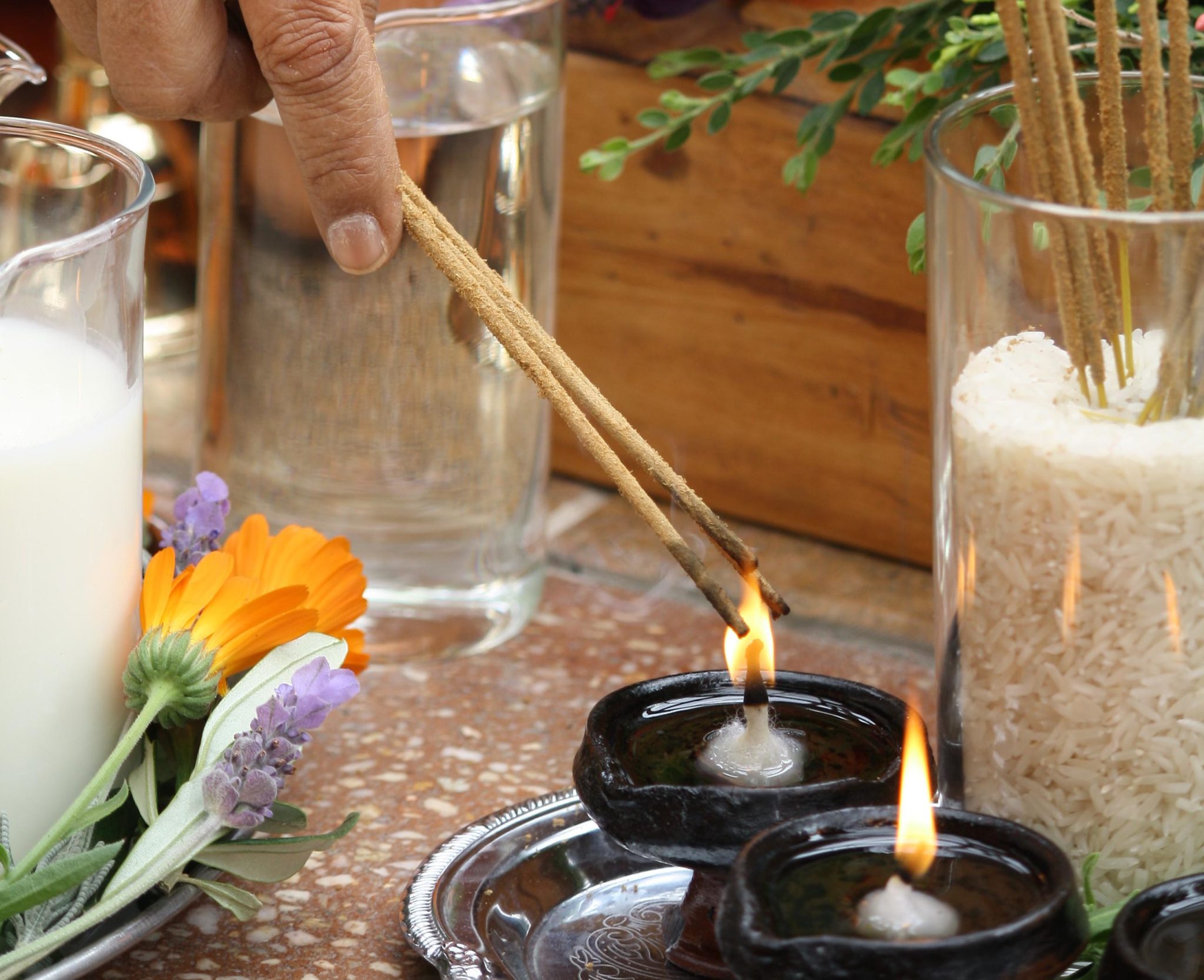
Rituals – Do We Need them or Not?
While we may think rituals in the Western world have faded as perceptions of religion and culture change, we still get up every morning and go through a sequence of activities such as making a cup of tea or coffee, bathing, brushing our teeth, dressing, putting on essential oils or having a shave in an ordered manner. We are often not conscious of these activities, as they have become habitual; yet, they are done at a certain time of the day or week, often in a particular way and they create a specific feeling. If you rush out the door without time for that “ritual” cup of tea, does it filter into your mood or your ability to perform your next activities?
Amidst the challenging time of covid-19, many of us are faced with the potentially isolating and stressful experience of lockdown. This is a great opportunity to practice implementing ritual into your routine, without the normal distractions that everyday life throws at us. Rituals are a reminder during these uncertain times, to reconnect with the little things which often pass us by in the mad rush to do more and more. May we slow down, if only for a moment, be more present, have more gratitude and connect to the natural rhythms of life.
What is Ritual?
The word ritual comes from the Latin ritualis – ‘that which pertains to rite (ritus)’. In Roman times this indicated a right or correct way of doing something, whether religious or legal and involved certain words and actions. The Vedas, ancient Indian texts containing many original teachings of yoga, have a similar concept reflected in the word Rta which translates as the proper functioning or natural order of the universe. It is thought that Rta may have been the original Sanskrit root of the word ‘ritus’.
While rituals, historically and in modern times, have often been associated with religious rites and ceremonies, if we look more closely they cross all aspects of our lives – a rite of passage, our first day at school all dressed up and apple in hand, a significant birthday, a particular way that we keep special items, the National Anthem or Haka before a sports game, a ceremony for graduation or grace before a meal or bed. Gestures, words, songs, and certain common themes or a particular way of doing something mark the honouring of significant points in our lives that may be related to personal experiences, our society, culture, family or religion.
Emma Hill-French describes a ritual as “a way of communicating with the rest of the universe through invocation and symbolic action. We invoke to invite in, whether it’s other people, a quality of awareness or an aspect of the divine. The symbolic action corresponds with the effect we’re trying to create.”
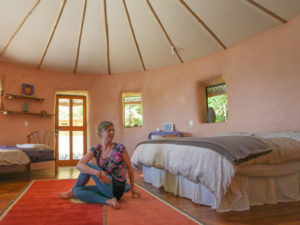
Bringing Ritual Back into Daily Life
In our fast moving world, we have perhaps begun to devalue the importance of rituals or feel we don’t have time for them. Although these rituals still form part of our lives, they may not hold the same significance as in prior times. One of the key concepts in yoga is developing presence in all actions. We practice this on the yoga mat through awareness of the body, mind or breath, but how can we be more present in daily life?
Often there is a ‘dis-connect’ between what we do for our health or spiritual self and our day-to-day activities. Thanks to the current world-wide slow down due to Covid-19, there is an opportunity to pause and evaluate our day to day life and create some new positive patterns. Adding small, conscious actions or rituals at pertinent points in our day, such as standing in the supermarket line, before a meal, at times of change, or regular occurrences like the full moon, is a way to build a bridge between the habitual unconscious experience and the mindful conscious field. Rituals can be tools to help create a pause in the busy-ness of life and reconnect with the self, our community, and the natural rhythms of nature. It is a link that allows us to use everyday activities for higher purpose and to translate the subtle inner experience into day-to-day life, so that over time there is no difference. Everything in life becomes the experience of yoga.

The Brain and Ritual
If the concept of ritual seems a bit airy-fairy or you feel too busy to pause, consider it from a brain science perspective. The brainstem is called the reptilian brain or the unconscious, instinctual and emotional brain. If a dangerous situation occurs, we don’t meditate on whether to move out of the way of a moving car. We instinctively move. Our evolutionary protection mechanism of “fight or flight” kicks in and physiological functions drive us towards survival. The fight or flight response is meant to protect us from starvation, wild beasts and threatening situations. Most of us have more than enough and wild animals are not perusing the malls, yet, the fight or flight instinct has become so over-activated that in many it is chronic. In these unprecedented times we as a global community are currently facing, it may be activated due to the uncertainty of the future.These instinctive mechanisms drive us to act from fear or protection, which if left unaddressed can be detrimental to our health and well-being.
Ritual, or performing a purposeful sequence of activities that may involve gestures, objects, music or offerings, is a conscious way to help us activate the higher brain centres. The frontal lobe of the brain is the region of higher cognitive functioning, connected to conscious thoughts and actions. Qualities such as planning and discriminating, as well as concentration, happiness, creativity and rational thinking, are associated with the frontal brain. Studies have shown that when we breathe without awareness, which is most of the time, the brain stem or lower brain is activated. However, when we consciously breathe, the frontal brain or higher brain is stimulated. Ritual, which may involve the breath, conscious action, concentration or creativity can be a tool to take us from the instinctual experience of life to a more aware, mindful and positive life.
Symbols and Ritual
According to psychology, the unconscious mind holds different life experiences as well as universal patterns as archetypes or symbolic images in the brain. These images may represent positive or negative experiences held in the unconscious mind. By using a symbol that we associate with something strengthening, peaceful or inspirational in a regular way, each time we focus on it there is an opportunity to reconnect to that quality. The brain scientists tell us that whatever we do regularly creates a neural pathway that makes that action or thought more likely to be repeated. We can use the ritual or offering to create new neural pathways, so that something that may have been unconscious or difficult in the past has a new, more positive association.
Do Rituals Have Rules?
Traditionally, rituals have come with strict sets of rules such as right and wrong ways of actions, worship or use of symbolic objects. However, when we look deeper, many symbols and objects span different cultures and religions. Because the same items can be used in different ways across various rituals and cultures, the rules become less essential. For example a candle can be found in a Catholic Church, a Buddhist or Hindu temple, a Pagan ceremony or a dinner ritual, each with its own set of rules. Although there may be individual associations with objects or actions, there are also many shared or universal meanings.
Symbolic items may be used as an offering before an activity or on an altar. They may be placed in front of your practice space, your dashboard, workspace or anywhere else you deem fit. You could begin to do something like chant a mantra or set an intention mentally each time you do the dishes. Or every time you stand in a line, do several yogic breaths.
Anything that has meaning to you can be used in a ritual. A co-facilitator at a women’s yoga event set up an altar representing the wise woman and the central piece was unexpectedly a pocket knife! She said that the pocketknife had all sorts of useful tools in it and that the wise woman with the experience of life had gained knowledge and tools to cut away what no longer served her. So anything goes.
A ritual can be done anytime and anywhere, however regularity is helpful for setting up a new pattern. Connecting with a significant other in a conscious way using principles of ritual can bring a new dimension to the relationship. Also, chanting, invoking energy or making offerings as a group, either in an online form or in a physical form when the lockdown ends, can magnify the experience of ritual.
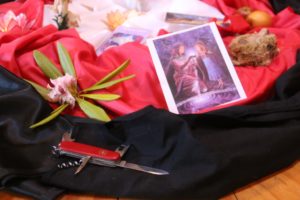
Yoga Nidra as a Ritual
Regular practice of any yoga or meditation form can become a conscious and ritualistic experience. Particularly in the times of challenge, Yoga Nidra is highly recommended as an important tool to calm the nervous system, develop mindfulness and to support our ability to manage life challenges. It helps us to rewire our brain so that we can stay more balanced in the face of difficulty. The stage of opposites during Yoga Nidra connects us with the primitive part of the brain that is responsible for survival. By consciously invoking opposite emotions and sensations, which are normally unconscious, whilst in a relaxed state of being, we grow our ability to stay calm and balanced in the inevitable ups and downs of daily life. We gain more mastery over both physiological and emotional experiences so that over time equanimity is more accessible. Particularly in a crisis situation, this ability to stay more balanced can be lifesaving. In terms of healing from crises, this stage of Yoga Nidra can give us access to that state of balance. By implementing the practice of Yoga Nidra as a regular ritual, we can empower ourselves to be ready to deal with whatever life throws at us. Visit our Soundcloud for a guided 30 minute 8 Stage Yoga Nidra.
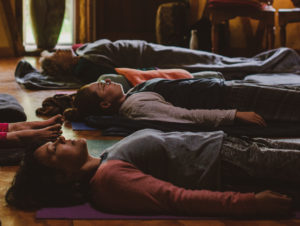
Building an Altar
An altar can be a table or space set-aside in the area being used for ritual. It can be a ledge, a part of your desk, a nature altar on the beach or perhaps a tree. Important items can be carried with you wrapped in a sacred cloth and roll them out wherever you decide to do a ritual. It is not necessary to have an altar. However, having a few items or a space with a central focus where actions are repeated for a higher or conscious purpose can be helpful in building a higher energetic field. Place anything that inspires you, whether a plant or natural item, a picture of a teacher or inspirational person, a poem or a statue – even just a candle or some stones or crystals will do. Any items that bring you peace of mind or inspire you can be used. Below are a few ideas on items and simple rituals you may like to incorporate.
Ritual Objects and Simple Rituals for Daily Life
Candle- lighting of the candle can represent igniting inner illumination, light to guide your idea, day or path, a flame of inspiration.
Flower– The flower has its roots in the earth where it is nourished and reaches up into the air where it blooms. It represents the journey from the unconscious mind rooted in the earthly experience and the evolution towards the light and flowering of higher consciousness. It is also a reminder of the beauty that surrounds us.
Incense– smoke of the incense acts as a purification for the space. The all-pervading fragrance can remind us of the expansiveness of higher experience. It also represents the air element.
Water– Sprinkling water or keeping some in a vessel represents cleansing at the inner and outer level. It also infers the watering of an idea or inspiration and signifies the water element.
Grains or Herbs- Herbs have specific healing qualities and grains can signify sustenance, abundance, enough for all. They are also connected to the earth element.
Tilak– This is a mark, often placed in the space between the eyebrows. It signifies the spiritual eye that sees without the physical eyes. A mark on this spot is traditionally used as a focus point for the mind in meditation, representing holding the attention on higher consciousness.
Perfume or Fragrance- Different essential oils or fragrances have particular meanings as well as effects on the physiology. For example, lavender is calming to the mind. Using a potpourri mix or particular fragrances can evoke a desired feeling.
Bell or Conch Shell-Ringing a bell or blowing a conch shell can represent shutting out the external and turning the mind inwards. It may also be a method of calling in the Divine to your ritual space.
Crystal and Stones– Each item has a specific quality and choosing one to include on an altar or part of your desk can help you focus on a certain quality of health, mind or spirit. For example, clear quartz is associated with clarity of mind and rose quartz signifies love and compassion.
Mantras or songs- Chanting a mantra such as OM or singing a song creates a particular vibration or emotion. Done before you go somewhere or prior to a yoga practice or meeting, it can set the space for the next action or be a way of honouring something important to you. Visit our Soundcloud for recordings of the Hanuman Chalisa Mantra, the Durga Mantra and the Maha Mritunjaya Manta.
Setting an intention or Sankalpa- Using a short positive statement of intent, especially if repeated regularly, sets up a constructive pattern in the deep mind, like watering a seed until it grows.
Gratitude- Giving gratitude not only reminds us of all we have to treasure, but new studies have shown that it produces dopamine which is the chemical related to reward and pleasure.
Reading a Poem, scripture or quote- By focusing the mind on something inspirational, especially at the beginning of a day or the start of a new endeavor, helps to ignite and sustain inspiration.
Breathing Consciously- Pick something you do regularly – standing in line, getting into your car, brushing your teeth – and use 3 or 7 conscious breaths each time you do that activity.
Shawls or clothes- Use a shawl or special clothes each time you meditate or are involved in ritual activities. It becomes imbued with the intention and energy created. Over time an association is formed and when you use that item, you more easily access a deeper space.
Mudras- Conscious gestures made with the eyes, hands, face or body set up a connection between the body and the mind through the nervous system. Simply put, the fingers touching each other in a particular way send a neural impulse to that area of the brain. A conscious effort to maintain the mudra engages the frontal cortex (higher brain) and builds energy through the neural circuit, which over time activates new areas of the brain. Like the shawl, a new association is formed that allows you to access whatever state that mudra represents more quickly.
Tarot or Affirmation Cards- Choose a card each day, before starting a practice or walking into a meeting to give you a focus for that activity.
Gods, Goddesses, Gurus, Inspirational People- You may like to place a picture or statue of something or someone that inspires you. If you associate a particular quality with that person or item, it may encourage you to emulate that. For example, the compassion of Mother Theresa may remind you to care for those around you. Or the image of the Indian Goddess, Laxmi, with money and fruit at her feet, may inspire you to think abundantly.
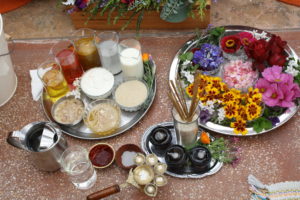
Biography
Swami Karma Karuna, director of Anahata Yoga Retreat, NZ, shares 30 years of experience including Therapeutic Yoga, Yoga Nidra Instructors Training, Prana, Chakras, Women’s Health and practical yoga for daily life. She teaches internationally including retreats in India and has several Yoga Practice, Meditation and Yoga Nidra tracks available on CD. Skype Private sessions are available by appointment: omsatyam@anahata-retreat.org.nz
Direct Quote References
Reference Sources
